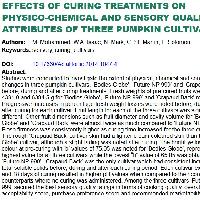Resumen
- Studies were conducted to investigate the extent of physical, chemical and sensory quality changes in three pumpkin cultivars, ‘Bodles Globe’, ‘Future NP 999’ and ‘Crapaud Back’ before, during and after curing treatments. Fresh weights of pre-cured fruits were 6882.0, 4391.0 and 6394.5 g for ‘Bodles Globe’, ‘Future NP 999’ and ‘Crapaud Back’ respectively. Progressive increases in percentage fresh weight losses were noted before, during and after curing for each cultivar. Fruit length for each of the three cultivars was significantly different. Other fruit dimensions such as fruit diameter and cavity volume for ‘Bodles Globe’ and ‘Crapaud Back’ were almost twice as much compared to ‘Future NP 999’. Flesh firmness was consistently higher as curing time increased for the three cultivars. The rough ‘Crapaud Back’ cultivar skin had a lighter cream coloured skin than the ‘Bodles Globe’ cultivar; although a slight fading was noted after curing. The bright yellow flesh colour at pre-curing with ‘b’ values of 75.05 was noted for ‘Bodles Globe’, representing the highest value for all three cultivars while the lowest “b” value of 65.85 was obtained for ‘Future NP 999’. ‘Crapaud Back’ was the only cultivar which had consistent increases in total soluble solids before, during and after each curing period. Each cultivar exposed to 9 and 18 days of curing resulted in higher pH values when compared to their control counterparts where no curing was administered. Among the three cultivars ‘Future NP 999’ secured the best sensory quality ratings in terms of cooking quality, overall acceptability score, purchase preference score and recommended marketability score.
